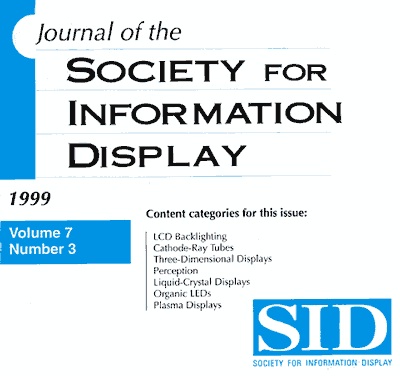3DTV JSID article
3DTV JSID article
HinesLab 3DTV-Image Formats
|
Liquid
Crystal Panels: |
2 rows 4 images |
3 rows 7 images |
4 rows 13 images |
5 rows 21 images |
VGA
|
Individual images:320 x 240 pixels |
= 76,800 total ea Individual images:213 x 160 pixels
= 34,080 total ea
XGA
1,024 x 768 =
786,432 total pixels
Individual images:
512 x 384 pixels
= 196,608 total ea.
Individual images:341 x 256 pixels
87,296 total ea.; 20"
demo at HinesLabIndividual images:256 x 192 pixels
= 49,152 total ea. Individual images:204 x 153 pixels
= 31,212 total ea.
SXGA
1,280 x 1,024 =
1,310,720 total pixels
Individual images:640 x 512 pixels
= 327,680 total ea. Individual images:426 x 341 pixels
= 145,266 total ea. Individual images:320 x 256 pixels
= 81,920 total ea. Individual images:256 x 204 pixels
= 52,224 total ea.
HDTV
1,920 x 1,080 =
1,987,200 total pixels
Individual images:960 x 540 pixels
= 518,400 total ea. Individual images:640 x 360 pixels
= 220,800 total ea. Individual images:480 x 270 pixels
= 123,840 total ea. Individual images:384 x 216 pixels
= 79,488 total ea. Exit pupils& width of
Figure 9 (below), Combinations of LC displays and image layout, indicating trade offs between image resolution, and audience space.
Much appreciated comment from the anonymous reviewer used by JSID to edit the article before publication:
"This paper is an excellent contribution to the Journal of the SID in that it clearly describes novel optical display technologies that help solve some vexing issues in stereoscopic 3D display systems: (1) how to provide different images to the L and R eyes without requiring the observer to wear special equipment or to keep the head in still in one spot, and (2) how to provide normal motion parallax cues (limited to horizontal motion in this case) and look-around when the observer moves laterally.
The figures and explanations are exemplary– if only more papers had this level of graphic excellence!
Again, let me congratulate the author on an excellent contribution to the literature on stereoscopic display design and technology."
….This is a technology announcement and license offer, not a product being offered for sale to end users. Photographic equipment manufacturers are invited to contact Steve Hines to arrange a demonstration or to discuss a manufacturing and sales license.
HinesLab
Glendale, California, USA
email: Steve@HinesLab.com











